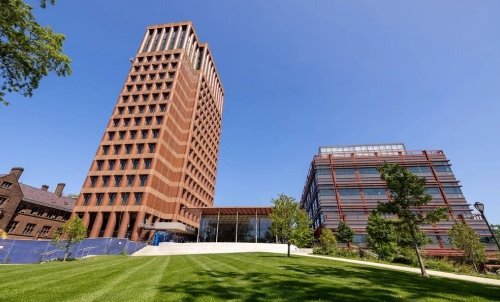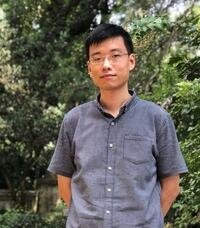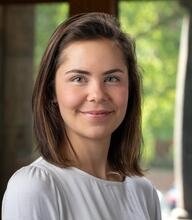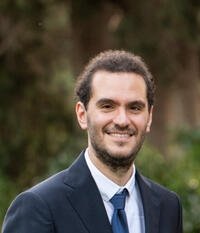A Data Renaissance in the FAS
With a focus on teaching and cross-disciplinary collaboration, Yale’s Department of Statistics and Data Science has expanded and evolved in recent years, more than doubling its faculty and moving to a central home in Kline Tower.

In March 2017, Yale’s Faculty of Arts and Sciences (FAS) reconceptualized what was then the Department of Statistics transforming it into a department of Statistics and Data Science (S&DS), a move that positioned Yale at the forefront of data-focused research and teaching.
In the ensuing five years, S&DS has expanded and evolved, recruiting faculty with a broad range of expertise, and creating connections within the FAS and across the university. Between 2017 and 2022, eight ladder faculty joined S&DS with primary or fully joint appointments. The number of new S&DS faculty has now grown to 15: six new ladder faculty accepted offers in 2022-2023 to join the department in 2023-24 or 2024-25, and an additional current FAS faculty member moved half of their formal appointment to S&DS.
A focus on faculty recruitment
This influx of faculty—who more than doubled the size of the existing department—is a result of the efforts of faculty, graduate students, and staff, and of inaugural FAS Dean of Social Science Alan Gerber, who oversaw recruiting and growth in S&DS and other FAS social science departments from 2014-2021. Dan Spielman, Sterling Professor of Computer Science and of Statistics and Data Science, spearheaded the ladder faculty searches in the Department of Statistics and Data Science for the past few years, and is the inaugural James A. Attwood Director of the Institute for Foundations of Data Science (FDS). He explained that new initiatives, including the Data Intensive Social Science Center (DISSC) and the FDS, helped bring faculty to Yale: “Prospective faculty know that there will be a lot going on. They can see that there are going to be events that are interesting.” As Spielman explained, the FDS will provide faculty with collaborative opportunities, conferences, and workshops beyond what they might find in their departments alone.
Building the S&DS faculty required faculty involvement from across the FAS and Yale’s professional schools. Kenneth Scheve, FAS Dean of Social Science, explained: “One of the challenges of recruitment is that the sorts of faculty [the department] usually identified had interest in working with graduate students and faculty across the university. Giving them a concrete vision of how that collaboration would work at Yale was an important part of successful recruitment. Recruits to the department wanted to know that there was a vibrant intellectual community that brought together people that are working on interesting theoretical and applied problems in statistics, and that everyone was getting together on a regular basis.”
Another draw for prospective faculty was the department’s move to Kline Tower in summer 2023. Before the move, the department was split across three buildings on Hillhouse Avenue. Now housed on three newly renovated floors in Kline, faculty can begin to rebuild the sense of community that department chair Joseph Chang, James A. Attwood Professor of Statistics and Data Science, remembers from when he first started at Yale in 1989. “When the department was smaller and all fit comfortably in the historic house at 24 Hillhouse, it felt like a family. Then we expanded into three separate buildings, and now it’s really nice to be back together in three floors of Kline Tower, with the FDS one floor above.” The department now has space for graduate student offices, meeting rooms, and other communal spaces. Spielman was excited to point out the white boards that cover most of the walls on each floor, and faculty have already begun using the frosted glass on their office doors to write out equations.
Prospective faculty also helped draw each other to Yale. Spielman noted that the department made offers to candidates whose research had synergies, and Scheve explained that the department was strategic with their offers. “The department first of all built on strengths in new areas by selecting candidates who were different than the people we had before, but they were going to be attracted to work with the existing faculty. And the candidates complemented each other, which led them to recruit one another.”
Cross-disciplinary connections and translational insights
As Spielman puts it, “for data science to thrive, it’s got to be grounded in things that help people.” With this ethos in mind, S&DS’s searches in 2023-24 focus on applied statistics and data science—an area that will allow the department to build still more bridges with other Yale departments and programs. Chang explained that candidates with applied expertise “could connect to multiple different areas, leading to joint appointments with other departments. We are looking for candidates who actively engage with applied research in other disciplines.” The department is already connected to other departments and schools: a large number of faculty in other FAS departments, the School of Medicine, the School of Public Health, the School of Engineering & Applied Science, and the Jackson School of Global Affairs have secondary appointments in S&DS. Spielman noted that these secondary faculty are instrumental in supporting projects for graduate and undergraduate students.
“A broad-reaching statistics and data science department will help data-focused research flourish across the university,” explained FAS Dean Tamar Gendler. “FAS faculty expansion in this area renews and strengthens Yale’s capacity to address critical social and policy problems.” Scheve “hopes that this is going to bring new methods and new ideas to other departments in the social sciences and across the university. In addition to the innovation and research produced by the department, there will be these network effects, these externalities, that will actually increase the quality and productivity of researchers across the division [of social science] and across the university.”
Expanded student interest
The transformation of the department coincided with the creation of the data science major for Yale College undergraduates. In 2017, there were five students who received a bachelor’s degree in statistics and data science; that number has ballooned to approximately 60 per year over the last three years.
The increased faculty size in the Department of Statistics and Data Science allows for the department to offer a greater number of these courses for Yale College students. “We have the opportunity and the challenge of really rethinking our curriculum now,” said Spielman. Scheve is currently on a committee considering how to deliver data intensive social science curriculum to undergraduates. “Part of a liberal arts education is to be able to think about empirical evidence and using data; having the larger department opens up a new set of possibilities that can have a big impact on Yale College offerings.”
New faculty in their own words

Lu Lu, Assistant Professor of Statistics and Data Science: My current research lies in scientific machine learning and artificial intelligence for science, a field that integrates statistics, mathematics, physics, computer science, and engineering. Yale's S&DS Department and the new FDS Institute provide me with an ideal platform to pursue my research.
In the newly renovated S&DS Department, FDS Institute, and Kline Tower, I have the unique opportunity to collaborate with faculty across dozens of disciplines, spark new insights, and make a transformative impact together.

Zongming Ma, Professor of Statistics and Data Science: Yale is making robust investments in science and engineering, and in integrative data science in particular as one of the top-priority areas, which also bridges naturally to data-intensive social science. I personally feel this is the best time to join the Yale Statistics and Data Science community. It is a vibrant scene, and it is just the start.
Exciting new data are being generated across the campus, and many opportunities for learning and collaboration await. I look forward to contributing to the development, the integration, and the expansion of data-intensive research and teaching on this campus. I feel truly excited to have the opportunity to play a pivotal role in this data science renaissance.

Ramina Sotoudeh, Assistant Professor of Sociology, secondary appointment in Statistics and Data Science: What most excites me about being part of the S&DS department is the interdisciplinary space that it provides for researchers to engage with complex data questions and share their disciplinary perspectives. As a person who develops and applies statistical tools to a diverse set of questions, from the structure of social attitudes to the role of genes in social outcomes, it has been so fruitful to share my work with other scholars at S&DS and learn from them about the unique and diverse problems they are solving. I love that we are working together to build a stronger statistical training curriculum, one that uniquely positions students for success in the new world of data that we live in, and I am excited for what the future holds for S&DS.

Ilias Zadik, Assistant Professor of Statistics and Data Science: I think there are a couple of very exciting new things happening around Yale S&DS, which impact me very positively as a new member. First, the department is growing a lot, with many faculty hires in the last years and a significantly growing student body as well. Second, the newly founded FDS Institute (just a floor above S&DS) is bringing a lot of research activity (such as seminars and multiple-day workshops) around the generic theme of foundations of data science that my research studies. Finally, the new offices in the Kline tower that the S&DS department moved in just this summer are really spacious and make working and collaborating very convenient for everyone in the department.
Faculty arriving July 2024
Sinho Chewi, Assistant Professor of Statistics and Data Science
Melody Huang, Assistant Professor of Political Science, secondary appointment in Statistics and Data Science
Theodor Misiakiewicz, Assistant Professor of Statistics and Data Science
Omar Montasser, Assistant Professor of Statistics and Data Science